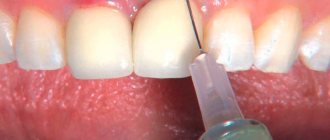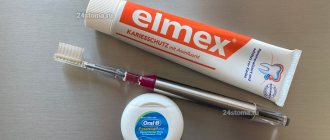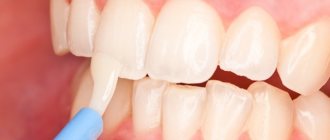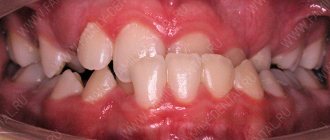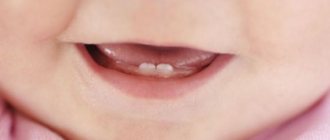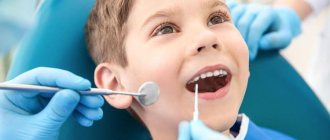Caries is treated using various methods depending on the stage of its development and the degree of damage to the tooth. At the initial stage, doctors use solutions to remineralize the enamel. The procedures are carried out in the clinic. For home use, special anti-caries remedies are prescribed: pastes, gels and rinses. Let's find out what makes them special.
In this article
- What is caries and why does it occur?
- Risk factors for dental caries
- Stages of caries
- Why should a dentist prescribe anti-caries medications?
- What remedies are there for caries?
- Tooth pastes against caries
- The best toothpastes for caries
- Gels for caries
- Anti-caries rinses
- Anti-caries preparations for internal use
- Other caries prevention measures
Treatment methods for caries are determined by the stage of the disease. You should also understand the nature of the pathology in order to choose the right remedy. However, it is immediately worth noting that it is impossible to cure carious lesions with tablets and toothpastes. Treatment is carried out by a dentist. If necessary, he will prescribe appropriate medications that can be used at home.
What is caries and why does it occur?
Caries is a pathological process that destroys the hard tissues of the tooth. The main reason for its development is the proliferation of cariogenic microorganisms from the Streptococcus mutans group in the oral cavity. Their waste products - acids - corrode tooth enamel, as a result of which there are fewer minerals in it that ensure its strength. It softens and exposes the hard tissues of the tooth. Further spread of bacteria leads to the destruction of dentin and damage to nerve endings.
Caries is a progressive pathology that does not go away on its own. If left untreated, you can lose a tooth or develop inflammatory diseases of the soft and hard tissues of the oral cavity - pulpitis, periodontitis, etc.
It is not always necessary to fill teeth. In the initial stages, it is possible to restore enamel using therapeutic methods. We will talk about the factors in the development of caries, after which we will describe the means used to treat it.
Risk factors for dental caries
Cariogenic microbes are present in the oral cavity of almost every person. But they become dangerous only if conditions are favorable for them. They are also called caries development factors and can be local or general. Among the first:
- Tartar. Poor oral hygiene leads to the formation of plaque on teeth. Over time, it hardens and turns into tartar. In it and under it there are many bacteria that easily destroy the enamel and penetrate the hard tissues of the tooth.
- Insufficient saliva production. Together with saliva, food debris and germs are washed out of the mouth. In addition, it contains substances that neutralize acids produced by bacteria. If the salivary glands are not working well, microorganisms multiply faster, which increases the risk of developing caries.
- Anatomical features of the jaw. Incorrect bite or tooth growth causes food debris to accumulate in the interdental spaces. Because of this, the number of microbes in the mouth increases.
- Poor nutrition. People who eat a lot of sweets are more likely to suffer from tooth decay. This is due to the fact that cariogenic microbes feed on carbohydrates.
Also, the likelihood of carious lesions increases with cardiovascular and endocrine diseases, problems with the gastrointestinal tract and weak immunity.
During treatment, it is important to eliminate as many factors as possible that cause bacteria to multiply. Various anti-caries remedies help cope with this. Let us describe the stages of development of the pathology, on the basis of which the method of its elimination is determined.
Stages of caries
There are 4 stages of caries, each of which has its own specific characteristics. During diagnosis, it is important to determine the extent of tooth damage in order to correctly prescribe treatment. Caries begins with the stage of a white (chalky) spot, which is an area of demineralization of tooth enamel. It loses its shine and looks slightly different from the rest of the tooth. However, only a doctor can reveal this during an examination.
The danger of the first stage is that the person does not feel any changes: his tooth does not hurt, his gums do not bleed, and there is no discomfort when chewing food. In fact, it is usually possible to detect caries at this stage only during a preventive examination, for which every person should come to the dentist once every six months. Otherwise, the carious process continues to progress.
At the second stage, the white spot darkens, acquires a brown or yellow tint and becomes noticeable if it is not localized on the inside of the teeth or between them. The first subjective signs of the disease also appear: discomfort is felt after eating sweet foods. The tooth becomes more sensitive, but this symptom disappears as soon as you rinse your mouth or brush your teeth. The carious cavity has not yet formed; the pathological process spreads along the enamel, but does not affect hard tissues.
In the first two stages, the disease can still be cured with therapeutic methods using anti-caries agents: solutions, pastes and gels. If a person ignores the symptoms, a carious cavity forms, indicating the beginning of the third stage. The tooth becomes more sensitive to sweet and sour foods, low and high temperatures, toothpaste and water. The pain subsides after the irritant is removed.
At the third stage, a hole is formed in which bacteria actively multiply. They penetrate the dentin, as a result of which the hard tissues of the tooth begin to deteriorate. At this stage, you cannot do without preparation and installation of a filling. Lack of treatment leads to the development of the fourth stage of caries, which is considered an advanced form of pathology.
Deep carious lesions cover at least ⅓ of the tooth. A brown cone-shaped cavity is formed. It is separated from the pulp by a thin partition of hard tissue. There is a risk of developing pulpitis - inflammation of soft tissues. In such cases, it is often necessary to remove the nerve. There is a high risk of tooth loss. At any moment it can split into several parts or break in the neck area if the carious process is localized near the gums.
Preventive examinations
Regular visits to the dentist will help prevent tooth decay or detect its presence at an early stage. Professional teeth cleaning is recommended 2-3 times a year. These procedures can be combined with examinations, which should be carried out at the same frequency. If there are no complaints, it is enough to visit a hygienist.
Only a specialist using professional tools can detect the disease at an early stage. As a rule, it appears as a white spot. Sometimes small dark dots appear. If the putrefactive process has affected the lateral groups of the dentition, then it is impossible to notice it on your own. Blind spots also include the inner surfaces of the incisors.
Patients usually discover caries when it is in an advanced form and a small cavity has already appeared. One of the signs of a problem is also increased sensitivity. If your gums begin to bleed, there are obvious discolorations on the enamel and pain, then it is advisable not to wait for a scheduled examination, but to immediately visit a doctor.
Why should a dentist prescribe anti-caries medications?
Medicines for caries are prescribed by a doctor. Treatment begins with procedures in the clinic. The dentist applies a special composition to the patient’s tooth affected by caries, which contains various minerals: fluoride, calcium, magnesium, etc. Several procedures may be required. Before they are carried out, ultrasonic cleaning is performed. It is necessary to clean the carious lesion from bacteria so that they do not interfere with the restoration of the enamel.
Only after this the doctor prescribes anti-caries medications that enhance the effect of the composition applied to the tooth. It should be understood that they do not cure, but prevent the further spread of pathology. In other words, they are means of prevention.
Infiltration method
Icon infiltration technology was invented at the Celtic University of Germany. This method of microinvasive treatment of caries refers to chemical-mechanical treatment, which completely eliminates tooth preparation - drilling, and is used only in the treatment of initial caries, initial carious lesions after using braces, as well as caries in the spot stage. The principle of operation of the method is to apply a special gel to the surface of the affected area of the tooth, which splits the enamel, after which the carious lesion is dried with 99% ethyl alcohol in combination with an air stream and impregnated with a polymer resin. The procedure protocol is clearly depicted in the figure below.
The positive aspects of this technology can be considered painless and quick (the procedure takes 15–20 minutes) removal of exclusively the affected part of the tooth. However, the method is applicable only on the smooth surface of the teeth or between them. Also, the shape of the “hole” should be ideal - with smooth edges and a wide entrance. International studies have confirmed the effectiveness of the infiltration method, which has made it possible to stop the development of caries for many years in both adult patients and children.
Tooth pastes against caries
There is no separate class called “anti-caries toothpastes.” However, some of them contain fluorides, which help restore enamel. When buying pasta, pay attention to the composition. It must contain at least 1000 ppm fluoride. If it is contained in a volume of 1450 ppm, the paste can be considered therapeutic and prophylactic. In the dentist's office, a tooth affected by caries is treated with a mixture with a fluoride concentration of 5000 ppm.
The following elements may also be present in the anti-caries paste:
- Calcium: Helps normalize mineral balance.
- Chlorhexidine and other antiseptics: indicated for patients with irregular oral hygiene.
- Abrasives: remove plaque from enamel. Instead, the paste may contain hydrogen peroxide. However, such compositions are contraindicated for deep caries. Moreover, they cannot be used continuously. The duration of use is determined by the doctor.
- Natural ingredients: suitable for sensitive gums and teeth.
Let's list specific toothpastes that help prevent the spread of caries.
The fourth stage - fluoridation
As a rule, fluoridation is not included in the calculation of comprehensive professional hygiene, but it is very important for dental health. The application of fluoride helps strengthen the enamel layer (prevents the leaching of calcium), reduces hypersensitivity, prevents the onset of caries (slows down the proliferation of pathogenic bacteria). Therefore, you should not refuse this procedure. Fluoridation algorithm: the doctor dries the surface to be treated with a warm air stream, then applies fluoride varnish (a harmless composition based on varnish with a high concentration of fluorides) to each element of the dentition, then dries it.
Note: after completing all stages of comprehensive cleansing, teeth become noticeably lighter, reaching their natural natural color. But those patients who dream of a snow-white smile can resort to whitening, for example, using the ZOOM-4 method.
The best toothpastes for caries
Therapeutic and prophylactic pastes are produced by various manufacturers. Let's present a rating of products that are approved by dentists and are in demand among customers of our online store.
ROCS "Active calcium"
Contains calcium, phosphorus, silicon and magnesium, which help saturate the enamel with minerals. They are integrated into its structure and protect against cariogenic microbes. It also contains xylitol, a naturally occurring antimicrobial component.
Weleda “With calendula”
A paste based on calcium carbonate, which effectively removes plaque from teeth and protects them from the spread of caries. Calendula included in the composition has an anti-inflammatory effect and a calming effect. The paste contains no synthetic components. It is prescribed to adults and children.
SPLAT Professional "Whitening Plus"
The composition includes polishing particles that brighten the enamel without damaging it or the gums. It also contains the substance Polydon, which ensures the breakdown of plaque in hard-to-reach places in the oral cavity. The paste has an antibacterial effect. It is ideal for smokers and coffee lovers. The concentration of fluorides in the composition is 1000 ppm.
Biorepair Plus Total Protection
This paste is prescribed for enamel hypersensitivity. The components included in it form a protective layer that protects teeth from external factors, reducing their sensitivity. The structure of some substances in the paste is identical to hydroxyapatite, the basis of the natural enamel surface and dentin. They penetrate the tooth, fill microcracks and restore the balance of minerals, preventing the development of caries.
CURAPROX Perio Plus Support
A paste used before and after dental surgery, for the prevention of gum disease, during the treatment of periodontitis and after installing braces. You can brush your teeth with it for 6 months. After this, you need to replace it with another paste.
Apadent Perio
It is prescribed for the first stage of caries. The composition includes ocean salt, which has a calming effect. The paste can be used by people with sensitive gums. It also contains antibacterial substances that destroy cariogenic bacteria.
PERIOE Pumping Original
One of the best pastes for caries prevention, containing fluoride at a concentration of 1400 ppm. It effectively removes plaque, neutralizes acids from microbes and destroys bacteria in hard-to-reach places. Pumping Original is available in a bottle with a dispenser, which ensures lower consumption.
Marvis Orange Blossom Bloom
Anti-caries paste with calcium and fluoride. It whitens well and helps restore the balance of minerals in the enamel structure. The composition includes a citrus flavor that freshens breath. Marvis is produced in unique retro style packaging.
Dentissimo Complete care
A paste based on herbal extracts with a calming effect, as well as calcium and hydroxyapatite in the composition. The last component follows the structure of the enamel and strengthens it.
Mirafluor C Toothpaste with Amine Fluoride
Paste to strengthen enamel and prevent caries. The main component of the composition is amino fluoride, a substance that effectively cleanses teeth of plaque.
These and other pastes for dental caries can be bought at a pharmacy or ordered in an online store. You should consult your dentist before purchasing.
Indications for strengthening enamel
- Caries at any stage.
- Baby teeth.
- Pregnancy and breastfeeding period.
- Discomfort or toothache while eating.
- Condition before and after teeth whitening.
- Orthodontic treatment (braces).
- Chips, scratches and cracks on teeth.
- Bite abnormalities and, as a result, pathological abrasion.
- Long-term drug therapy.
Gels for caries
Anti-caries gel is another remedy that helps restore enamel and protect teeth from caries. Such products contain minerals, like toothpastes, and other components that help strengthen teeth and destroy bacteria. Gels are similar in composition to special varnishes that dentists use to remineralize the enamel of patients with carious lesions. The doctor applies the varnish to the tooth, and then shines a lamp on it so that the liquid hardens. The advantage of gels over varnishes is that they can be used independently at home.
The gel should be applied after brushing your teeth with toothpaste. For application, you can use a swab or cotton swab. To enhance the effect of the product, it is recommended to wear a mouth guard. The choice of gels is as varied as the toothpastes. The most popular products are:
- Stomysens® Desensitizing Repairing Treatment 4.
- DRC ROCS (ROCS) Medical Minerals.
- Dental Resources Inc Sorbet Revive.
- Curaden AG for gums CURAPROX Perio Plus Focus CHX 10.
- Cumdente Gmbh ApaCare Repair “Liquid enamel”.
There are no contraindications to gels, but they can only be used after examination by a dentist.
Third stage - polishing
Deposits leave microcracks and irregularities on the enamel layer. Therefore, polishing is necessary after cleaning procedures. Otherwise, the remaining roughness will become a “magnet” for microparticles of food, which will very quickly turn into new deposits. Polishing is performed using abrasive pastes and various attachments driven by a drill. These are polishers, brushes, discs, needle-shaped attachments. The interdental areas are polished with special strips. The process does not cause pain and takes about 40 minutes.
Anti-caries rinses
Mouth rinses and balms can be used continuously. Their main purpose is disinfection of gums and mucous membranes. Similar remedies are used after every meal. They can also be used in conjunction with irrigators to clean the oral cavity.
When choosing a mouthwash, check the ingredients. Make sure that you are not allergic to any of the liquid components. Some products contain calcium, soothing and anti-inflammatory substances. As an example, we indicate the following balms and rinses:
- Vivax "Remineralization".
- CURAPROX Perio Plus Forte chx 0.20%.
- Biorepair Delicate Gums Mouthwash.
- ROCS "Active calcium".
The enamel of children's teeth is just being formed, so it is more vulnerable not only to cariogenic bacteria, but also to various cleaners. For this reason, it is better for children to choose children's products: Levrana “Blueberry” or “Albadent for children”. They do not contain abrasive substances or components that can cause allergies and irritation of the gums or damage the enamel structure.
Choosing a filling
The most commonly used today are light-curing composite fillings. They are durable, aesthetic, and have minimal shrinkage. Such materials have a wide range of colors. When treating a front tooth, the doctor may recommend a more expensive material with a wide range of shades.
Glass ionomer cements, which cost less and contain fluoride, can also be used for filling. But this material is more fragile, therefore it is used mainly in pediatric dentistry.
Not only light-curing, but also less expensive cement and amalgam fillings can be installed on chewing teeth. However, today they are used less frequently.
Anti-caries preparations for internal use
Today you can buy anti-caries tablets that contain calcium gluconate and other minerals. Vitamins and microelements must enter the body with food. If they are not enough, you need to take appropriate medications. They are prescribed by a doctor. During the development of the carious process, the following vitamins are necessary:
- A: increases the resistance of enamel to external factors.
- B1: binds calcium, which strengthens teeth.
- B6: accelerates metabolic processes and tissue regeneration.
- C: increases the strength of crowns.
- D: strengthens bone tissue.
- E: neutralizes harmful acids after sweet foods.
It is worth understanding that it is not possible to cure caries with the help of tablets. They are used only as an additional means. Let us remember that pathology can occur due to weak immunity. If it is not strengthened, caries and other diseases will recur. For this reason, it is recommended to approach the treatment of carious lesions in a comprehensive manner.
How to treat caries: the main stages of the treatment process to be completed
Treatment of caries always begins with diagnosis, which establishes the stage of development of the disease. Diagnostic measures for caries may include a visual examination, the use of special caries indicator drugs, a laser, and radiography (a targeted picture is taken).
Based on the data obtained during diagnosis, the optimal caries treatment method for a specific clinical case is selected. Most often, a classic treatment regimen is used, which involves drilling the tooth with the removal of destroyed tissue, treating it with antiseptics and drugs that destroy the infection, and restoring the natural crown of the tooth with a light-curing filling.
Take a short test and calculate the cost of treatment!
Take a short test
Other caries prevention measures
During treatment you will have to completely give up sweet foods. It is also necessary to exclude excessively salty and sour foods from the diet. It is recommended to quit smoking, as tobacco smoke contributes to the formation of plaque and tartar. To better clean the oral cavity from food debris and microbes, you can use irrigators, but not as an alternative to a toothbrush. Visit your dentist every six months for a check-up.
Second stage – Air Flow
After removing hard contaminants, it is time for deposits with a soft structure. Cleansing is performed using Air Flow technology. Using a special apparatus, a mixture of water, air and tiny grains of soda is applied to the surface of the patient’s teeth. The abrasive size is so small that it can destroy the bacterial film, but cannot leave scratches on the enamel surface. A stream of abrasive mixture directed under pressure destroys pigmented plaque and immediately washes it away. Thanks to this, the enamel is lightened to its natural tone (by about 1 - 2 shades on the Vita scale).
Note: the process is painless, but may cause slight discomfort for people with hypersensitive enamel. In this case, the doctor may suggest local anesthesia. Patients who are allergic to soda should not perform this cleaning.

